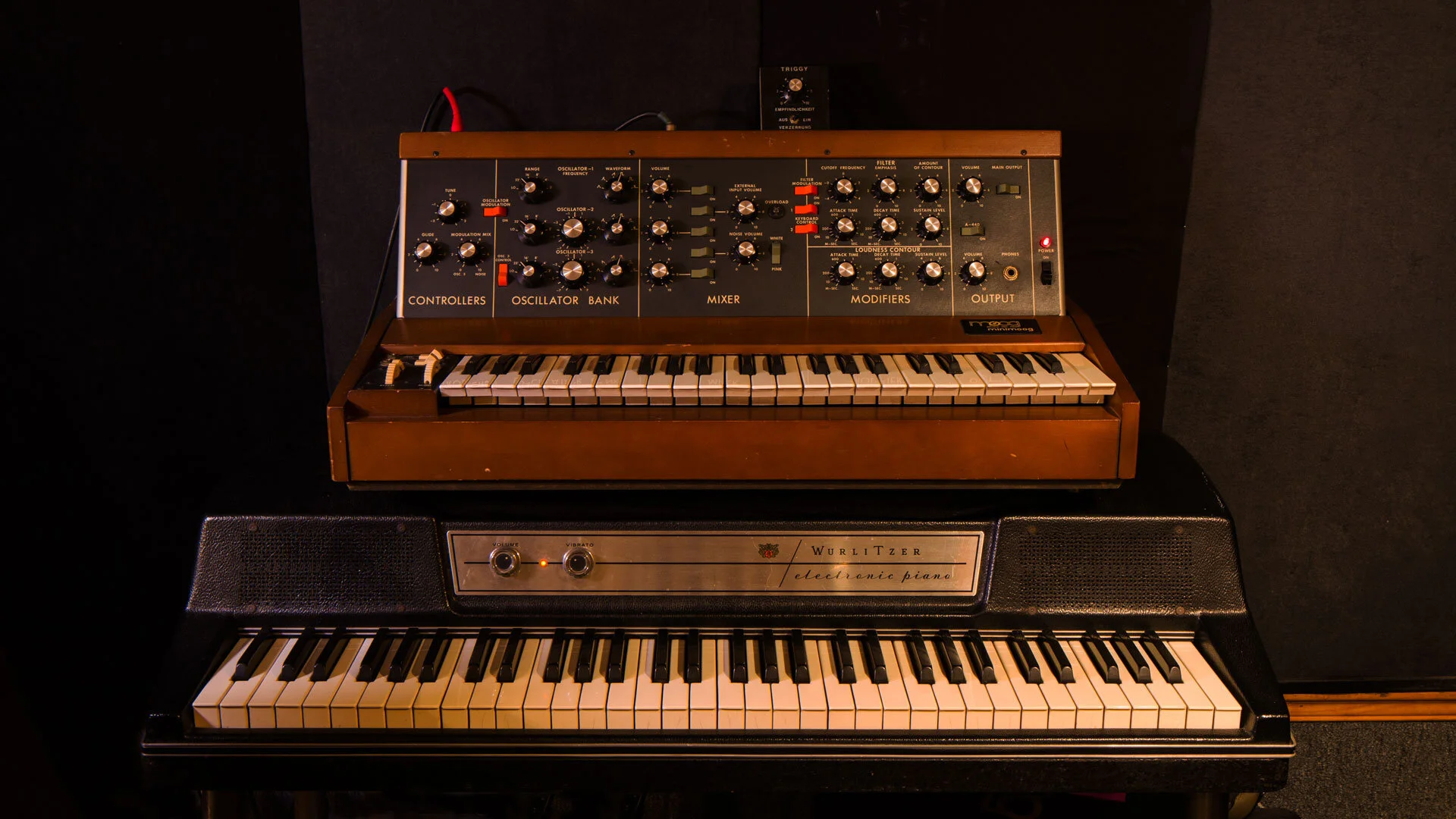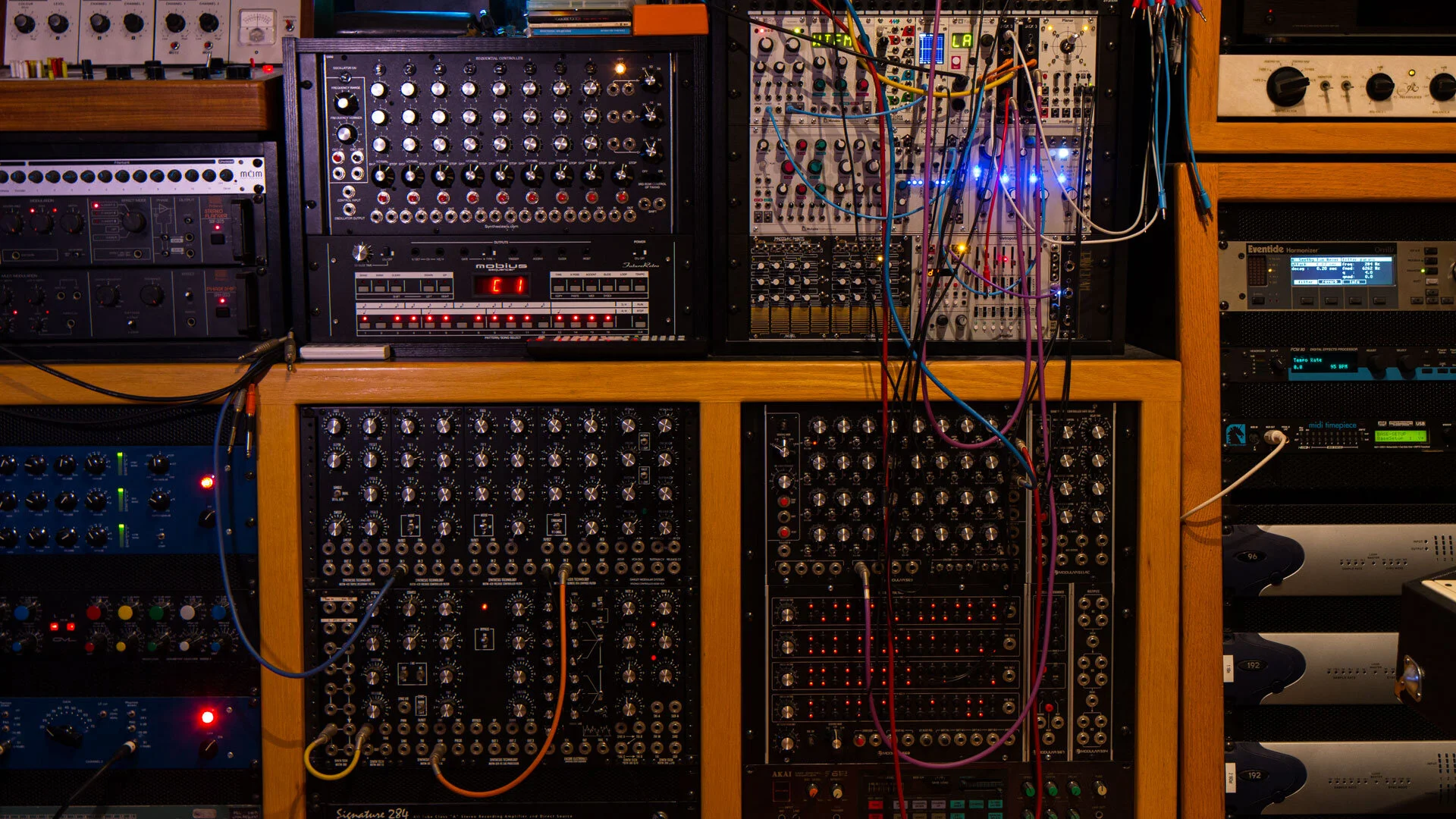2018
also known as “Vintage Synth Studios”, in Santa Monica, California
Projects: Film Scoring for the documentaries: “Laserium, the Gods of Light” and “Sky People”.
Artists: Sam Wilder, Maty Noyes
Our mission is to preserve the importance of the synthesizer as a real instrument. Just like a drum machine didn’t replace a drummer and a sampler couldn’t replace a guitar, a virtual synth can not replace a real analogue synthesizer. At Vintagesynthstudios you can experience the unique sounds of a vintage synthesizer that records with the qualities of an timeless acoustic instrument.
Please scroll lower for audio and video samples:
from the left: EMS VCS 3 (Putney), Modular with 10 sequencers, Lexicon 480, Eventide Orville, Tube Tech SMC2B, GML 8200
in the front: Memorymoog Plus, Oberheim Matrix 12, Oberheim FVS w/midi, Oberheim OB 8
in the back: :original Mini Moog D, Wurlitzer 200 A, Roland SH3a, Roland Vocoder VP 330, PPG Wave 2.2, Roland SH 7, Roland SH 5, Virus Access B, Sequential Circuits Prophet T8, Nord Lead 2,
Pro Tools w/32 inputs, Final Cut Pro, 14 ft Screen,
5.1 THX Theater system with 2 x 18” subs
EMS, VCS 3 (the putney)
top: Memorymoog bottom: Oberheim Four Voice
Oberheim Matrix 12
Oberheim OB 8
top: Roland Vocoder VP 330 bottom: PPG Wave 2.2
top: Roland SH 7 bottom: Roland SH 5
top: Mini Moog D bottom: Wurlitzer 200 A
Modular Section: MOTM, Moon, Sequencers, Eurorack, Outboard
Audio / Video Samples of the instruments:
Oberheim Four Voice SEM: Sweeping the filter on a pad where each voice of a chord, has it’s own complete synth module with it’s own tuning, filter, envelope and LFO settings. Having them all very similar but not quite, allows for the four filters to sweep at four different points, which makes it extra fat.
One the four modules filters set to Band Pass while the others are set to Low Pass. Then tweaking the filter type on module #4 from Low Pass to High Pass just ever so slightly. Then changing the wave form on module #3 from saw to square so one out of four notes in the sequence plays with a square and three others play with saw tooth.
Oberheim OB 8: Chord sequence starts out with square waves only, then add a saw on the second VCO, then switch first VCO from square to saw. The new sound is triangles only on the VCOs, so as it’s playing it’s nice to open the filter gradually, then close it for the end.
Arpeggio Sequence turns into drone pad. First adding to Mod amount and open the filter, then pushing up the Attack on the Filter ADSR. Then pushing Resonance to the max and brining the Cut off down again.
The Oberheim Matrix 12 has the softest pads of them all, no reverb, just VCAs and filters ringing out.
A Memorymoog sounds very different from an Oberheim. It has 3 VCOs per voice, but it’s mono, so no stereo swirls. The special thing about a Memorymoog is the Resonance Filter, it sound sounds like no other, it dos not have the regular hard high pitched feedback sound but a smooth organic almost ring modulating sound.
2008
The "analogue difference within the digital difference", was the studio from 2005 to 2010. On Olympic, neighboring J.J.Abrams building, it was the sound and music facility within a digital picture house.
Now there are 2 HUI's integrated into the Harrison 3232 C which came from the Village Recorders’ D room - Gaucho was mixed on it. Here it is used for simultaneous analog and digital mixing. The big screen hides a gigantic THX mix room (with THX plaque) acquired from the old Atlantic Records building in West Hollywood. Now installed into this tiny room it sounds bombastic.
The racks feature Focusrite Red2EQ, TubeTech Multiband Compressor, Lexicon 300, PCM 90 & 80, EMS VCS 3 on top of it. Mini Moog D sits on top of a Roland Space Echo RE201. Micro Lynx controls 24 track and video in the invisible machine room behind. And the beginnings of a MOTM modular on the left.
Last but not least: a Scully record lathe I acquired from A&M records in 1999 finally set up and running. This is the machine from their mastering room #1 and is essentially Bernie Grundmans' old lathe that produced masters for Police, Janet Jackson, Sergio Mendes, Herp Alpert, etc.
It's the best of technological achievements from 4 decades of record mastering: a Scully Lathe (#480) from the 1960's with a Capp's computer from the 1970's, a Neumann head assembly from the 1980's and a brand new cutter head from the 1990's. There is a microscope on the left to inspect the grooves after you cut them and the cylinder mounted to the wall on the right is the "chip" container that catches the tiny little strings of vinyl that are cut from the blank thru a vacuum system. beware: you need a "hazardous waste permit" to cut master vinyl records.
2002
B Room at the old “Scotti Brothers” Studio in Santa Monica where James Brown, Michael Jackson and Weird Al recorded. Neve 8108 with HUI on the left.
1998
Home Studio with Harrison 3232C
Oberheim Matrix 12, Nord Lead 2 & Mini Moog on the right.
Prophet 10 on the left. MCI 24 track 2”, BVU 950 3/4” video deck


















